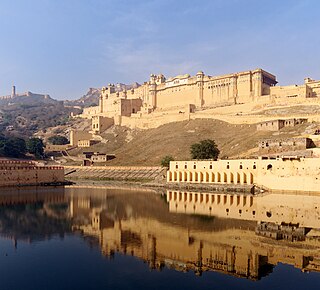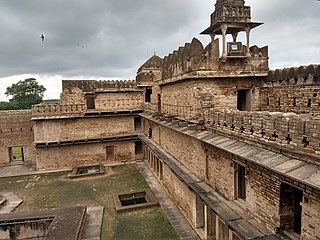
Orchha is a town, near the city of Niwari in the Niwari district of Madhya Pradesh state, India. The town was established by a Bundela rajput ruler Rudra Pratap Singh some time after 1501, as the seat of an eponymous former princely state of covering parts of central & north India, in the Bundelkhand region. Orchha lies on the Betwa River, 80 km from Tikamgarh & 15 km from Jhansi in Uttar Pradesh.

The Kachhwaha, or Kachhawa is a Rajput clan found primarily in India.

Amer Fort or Amber Fort is a fort located in Amer, Rajasthan, India. Amer is a town with an area of 4 square kilometres (1.5 sq mi) located 11 kilometres (6.8 mi) from Jaipur, the capital of Rajasthan. Located high on a hill, it is the principal tourist attraction in Jaipur. Amer Fort is known for its artistic style elements. With its large ramparts and series of gates and cobbled paths, the fort overlooks Maota Lake, which is the main source of water for the Amer Palace.

Guna district is one of the 52 districts of Madhya Pradesh in central India. Its administrative headquarters is Guna. The district has a population of 1,241,519. It has an area of 6390 km², and is bounded on the northeast by Shivpuri District, on the east by Ashoknagar District, on the southeast by Vidisha District, on the southwest by Rajgarh District, on the west and northwest by Jhalawar and Baran districts of Rajasthan state. The Sindh River flows northward along the eastern edge of the district, forming part of the boundary with Ashoknagar District, and the Parvati River flows northwestward through the southern portion of the district, forming part of the boundary with Baran District before flowing into Rajasthan.

Ashoknagar District is a district of Madhya Pradesh state in central India. The city of Ashoknagar is the administrative headquarters of the district. Ashoknagar district was formed in 2003.

The Gwalior Fort, commonly known as the Gwālīyar Qila, is a hill fort near Gwalior, Madhya Pradesh, India. The fort has existed at least since the 10th century, and the inscriptions and monuments found within what is now the fort campus indicate that it may have existed as early as the beginning of the 6th century. The modern-day fort, embodying a defensive structure and two palaces was built by the Tomar Rajput ruler Man Singh Tomar. The fort has been administered by a number of different rulers in its history.

Jalore Fort is the main attraction of Jalore, a town in the Indian state of Rajasthan, one of the nine castles of the Maru, under the Paramaras in the 10th century. It is one of the most famous and impressive forts in the state and has been known through history as the Svangiri or the "golden mount".This fort is a symbol of the valor of Songra Chauhans. The Songra Chauhans made their name all over the world by defeating a cruel Turkic emperor like Alauddin. Veer Veeramdev and Rao Kanhadded Dev defeated a power like Alauddin from this fort to protect their motherland with their valorous might. This fort is a symbol of the valor of Songra Chauhans.With the blessings of Kuldevi Maa Ashapura who is also known as Modara Mata. Chauhan gave a different direction to Jalore and to the fort.
Aklera is a town and an Indian municipality in Jhalawar district in the state of Rajasthan. It is in the south-eastern region of Rajasthan at the edge of the Malwa plateau and has a rocky, scrub-covered terrain.
Raghogarh-Ruthiyai or Raghogarh-Vijaypur is a town and municipality in Guna district in the Indian state of Madhya Pradesh.

Narsinghgarh is a town and a municipality, near Rajgarh city in Rajgarh district in the Indian state of Madhya Pradesh.

Moti Masjid, one of the "Pearl Mosques", is a 17th-century religious building located inside the Lahore Fort, Lahore, Punjab, Pakistan. It is a small, white marble structure built by Mughal emperor Jahangir and modified by the architects of Shah Jahan, and is among his prominent extensions to the Lahore Fort Complex. The mosque is located on the western side of Lahore Fort, closer to Alamgiri Gate, the main entrance.

Chaturbhuj Temple, dedicated to Vishnu, is situated at Orchha in Madhya Pradesh, India. The name Chaturbhuj is a combination of 'chatur' meaning "four" and 'bhuj' meaning "arms" which literally translates to "one who has four arms" and refers to Rama an Avatar of Vishnu. The temple has a complex multi-storied structural view which is a blend of temple, fort and palatial architectural features.

The culture of Rajasthan includes many artistic traditions that reflect the ancient Indian way of life. Rajasthan is also called the "Land of Kings". It has many tourist attractions and facilities for tourists. This historical state of India attracts tourists and vacationers with its rich culture, tradition, heritage and monuments. It also has some wildlife sanctuaries and national parks.

Raghogarh State, also known as Raghugarh and as Khichiwara, was a princely state of the Gwalior Residency, under the Central India Agency of the British Raj. It was a Thikana state of about 109 km2 with a population of 19,446 inhabitants in 1901. The Parbati River marked the western border of the state. The capital was at Raghogarh in present-day Guna district of Madhya Pradesh.

Moti Dungri is a Hindu temple complex dedicated to Lord Ganesha in Jaipur, Rajasthan. It was built in 1761 under supervision of Seth Jai Ram Paliwal. The temple is a popular tourist attraction in the city and is located next to the Birla Temple.
Karnagarh is a village and a gram panchayat in the Salboni CD block in the Medinipur Sadar subdivision of the Paschim Medinipur district in the state of West Bengal, India.
The Narajole Raj was a medieval royal dynasty and later a zamindari (estate) during the British period at Narajole in Paschim Medinipur district in the state of West Bengal. The Raja of Narajole was one of the largest landholders in Midnapore. The kings of Narajole belonged to the Sadgope community and had a close link with the rulers of Karnagarh.

The Midnapore Raj or Karnagarh Raj was medieval dynasty and later a zamindari estate of Sadgop during the British period in the Paschim Medinipur district in the state of West Bengal, India. The semi - independent Rajas of Karnagarh were amongst the most powerful rulers of Jungle Mahal region.

Nawal Sagar Lake is an artificial lake or reservoir situated in Bundi city in the state of Rajasthan in India. It is surrounded by the hills of the Aravalli mountain range. It is a square shaped artificial lake, and a temple dedicated to Varuna, the God of ocean, is partially submerged in the middle of the lake. Nawal Sagar is surrounded by towering walls and has two gateways that serve as entry points to the lake. It is located in the centre of the Bundi city.














